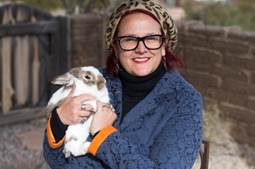|
THE SCIENCE OF CONSCIOUSNESS April 25-30, 2016 - Tucson
Pre-Conference Workshop - MONDAY AFTERNOON Monday, April 25, 2016 (2 pm to 6 pm)
Consciousness in Animals What is it like to be a rabbit? With various techniques, an interdisciplinary team looks at conscious experience of wolves, dolphins and rabbits. Language professor Julie A. Smith will use scientific studies, optic devices (mirrors), narratives of atypical human experience, and altered photographs to demonstrate the unusual lateral vision of rabbits. Using live demonstrations with rabbits, as well as video of a stable domestic rabbit community, anthrozoologist Margo DeMello will describe social and self-awareness in complex hierarchies and territories, as well as transient functional friendships Psychologist Robert Mitchell will ‘reverse anthropomorphism’ by having workshop participants perform problem-solving tasks involving mental imagery, insight, and projection generally used in animal studies. Philosopher Sara Waller will survey measures of consciousness and language in wolves and bottlenose dolphins, e.g. dolphin signature whistles, coalition calls, object naming and problem solving. Presenters Margo DeMello Robert W. Mitchell Julie A. Smith Sara Waller
Description and Goals This workshop provides a multidisciplinary examination of the conscious experience of several non-human animal species. Activities engage participants in the evaluation established scientific, artistic, and humanistic methods for measuring, understanding, and even experiencing types of animal consciousness, coding, and cognition. Dr. Smith will open the workshop by bringing us into the world of rabbit lateral vision, asking if a different visual mode gives rise to a different kind of consciousness. Starting with scientific data about significant features of rabbit vision, she will investigate analogues in exceptional visual experiences of humans. Participants will perform exercises that alter visual habits along lines compatible with what is known about rabbit vision. Non-standard narrative devices, optic illusions, and altered photographs will be used to manipulate participants’ visual awarenesses to the end of asking whether they give rise to a different kind of consciousness. Dr. DeMello will approach rabbit consciousness from the problem of their social and self awareness. Domestic rabbits who live with other rabbits do so in complicated social structures bound by rules of hierarchy and territory, as well as more mutable concepts like friendship. How do rabbits go from being strangers to becoming a community in what is essentially a fission-fusion society? If one looks at the process of going from “one to many,” we might ask, ‘Do rabbits have a model in mind from the outset for creating what will become their new social structure?’ ‘What roles emerge from the initial encounter that are necessary for the final structure, and what kind of understanding do the individuals who assume those roles seem to have?” This session will begin with a video of a long-standing, stable rabbit group. It will then bring together 8-10 stranger rabbits to demonstrate what the initial encounter looks like. Throughout the demonstration, participants will comment on what they are seeing. Dr. Mitchell will ask participants to “reverse their anthropomorphism” by working through several problem-solving tasks usually given to animals in comparative psychological studies. In most of these, animals are presumed to experience mental imagery, insight, projection, and other forms of cognition. Participants will engage in these same tasks and will be asked to reflect on their experience. By this means, participants can explore whether the forms of consciousness presumed to be present in animals are present or absent in humans. This assessment will, of course, have implications for the types of conscious activities animals might have in solving similar problems. Dr. Waller will close the workshop with a survey of current methods for measuring the consciousness and cognition of wolves and bottlenose dolphins. She will present research on dolphin signature whistles, coalition calls, object naming and problem solving. Participants will view videos of wolf and dolphin behavior and engage in a mock data-taking activity designed to raise questions about our methods for understanding dolphin minds through standard behavioral categories. She will then review current philosophical questions regarding consciousness and cognition, including their relationship to language, as they pertain to empirical measures of animal minds.
Workshop Outline: Smith
DeMello
Mitchell
Waller
Sara Waller is an Associate Professor of Philosophy at Montana State University, where she teaches courses on animal cognition, canid vocalization and the evolution of consciousness, logic, and philosophy of astrobiology. Her research focuses on the relationship between vocalizations and the conceptual categories, cognition and communication in non-human animals. Specifically, she explores the minds, mental states and intelligence of cooperative predators, such as human serial killers, coyotes, wolves, dolphins, and house cats. She has published in such journals as Cognitive Semiotics, Synthese, and Journal of Cognitive Neuroscience.
Margo DeMello received her Ph.D. in Cultural Anthropology from U.C. Davis in 1995, and is an adjunct professor in the Anthrozoology Masters program at Canisius College. She is also the Human-Animal Studies Program Director for the Animals and Society Institute, and President of House Rabbit Society, an international rabbit advocacy organization. Her books include Stories Rabbits Tell: A Natural and Cultural History of a Misunderstood Creature, Teaching the Animal: Human Animal Studies Across the Disciplines, Speaking for Animals: Animal Autobiographical Writing, Animals and Society: An Introduction to Human-Animal Studies. Her newest book will be the edited collection titled Mourning Animals: Rituals and Practices Surrounding Animal Death.
Robert Mitchell, Ph.D., is Foundation Professor in the Department of Psychology at Eastern Kentucky University. He is the coordinator for both the interdisciplinary Animal Studies program (which he founded with the support of other faculty) and the General Psychology Masters program. He has edited and co-edited books examining a range of psychological topics about animals and children, including deception, pretending, imagination, self-recognition, and spatial cognition, produced a monograph on the history of psychological studies of great apes, and published numerous articles and book chapters on the psychology of animals and on human-animal interaction. He has studied animals of several species, including dolphins, apes, monkeys, sea lions, dogs, and humans, and has also written extensively on the relations among self-recognition, imitation, and understanding other minds. He is working on a book about the history of ideas about using anthropomorphism to understand animals in science, and is collaborating on studies of Galapagos sea lions, focusing on their play and their interactions with people.
Julie A. Smith is Associate Professor Emeritus from the Department of Languages and Literatures at the University of Wisconsin, Whitewater. Her animal-related articles focus on representations of animals’ minds in cultural discourse, particularly in literary works. This year she will have two articles published, including “Representing Animal Minds in Early Animal Autobiography: Charlotte Tucker's The Rambles of a Rat (1857) and Nineteenth-Century Natural History” (Victorian Literature and Culture) and “Death of a White-Tailed Deer in David Lynch’s The Straight Story (1999) (in Lives Beyond Us: Poems and Essays on the Film Reality of Animals, Sidekick Books). She is co-editor of Experiencing Animal Minds (Columbia University Press, 2012). Smith is active in animal rights and animal welfare, founded the Wisconsin chapter of the House Rabbit Society, and maintains a sanctuary of twelve rescued rabbits. She is currently working on a book which examines six major interpretive problems in rabbit behavior as gateways to understanding rabbit consciousness.
Early Workshop Fees: TSC Student Registrants $40 half day TSC General Registrants $60 half day General Public - Student - Workshop only $75 half day General Public - Workshop only $125 half day |
|
|||||||||||||



